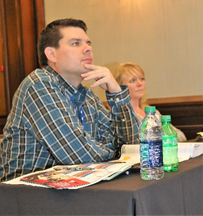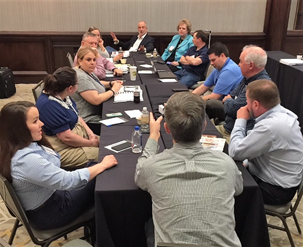The VMA Knowledge Forum, Part Two: The Human Factor
Finding and retaining the right talent is a continual challenge to manufacturers who say the skills shortage has negatively impacted their ability to expand.
#VMAnews
A Resource for Manufacturers
Chuck Spangler, president of South Carolina Manufacturing Enterprise Partnership (SCMEP), showed several examples where a good talent strategy, combined with defining and communicating the needs of a workforce has improved many manufacturing plants in South Carolina. The SCMEP is one of 51 centers of the national MEP, which works on a short-term basis with small and medium-sized manufacturers to help them increase and retain jobs and sales, as well as increase profit. In the last year, MEP has been responsible for reaching over 25,000 manufacturers and completing 8,000 projects annually.
When it comes to training, Spangler observed that it’s more important to determine from candidates what they can learn as opposed to what they know. Cross-training is essential, and competencies are much more valuable than degrees. He also warned that successful training today does not entail the use of manuals. “Virtual reality is the thing!”
He also stressed the need to actively market your company. One vehicle for doing this is Manufacturing Day (held the first Friday of October), which Spangler said is “one of the things that is really making a difference with young people.” He encouraged companies to open their facilities. Studies conducted by the National Association of Manufacturing (with support from The Manufacturing Institute and Manufacturing Enterprise Partnership) have shown that young people, and their parents, who often have a negative view of manufacturing, experience a significant, positive change in their point of view after touring a modern manufacturing facility.
Recruitment and Training
Tiffany Gearhart, national trainer and recruiting specialist at AIRS, powered by ADP, compared hiring candidates to a customer journey. She pointed to the parallels between in-bound marketing and recruitment. By following the same process used to attract and retain customers, employers will have a higher success rate recruiting good talent.
It’s also essential to have a stellar onboarding program to ensure new employees understand exactly what is expected, feel welcomed into their new position and know they can ask questions and not be demeaned for doing so.
She pointed out that training provides a competitive advantage compared to companies that do not invest. “It conveys a worth to your staff, and that they are important to your business. It shows someone new that they are not locked into their position forever,” she said. “It can also be an effective retention tool because it is seen as a pathway to success, leading to increased employee engagement.”
While it’s important to grow talent from within, sometimes it is necessary to hire from the outside. Knauss suggested that you use a temporary workforce to determine if potential employees can do, and like, the job. “It’s better to find that out in the first few days or weeks than to invest a lot of time and money and then have them leave!” she said.
She also asked: “Do you spend too much time on the troublemakers? What about the star performers?” and warned managers not to forget their “Steady Eddies.”
Employment Law
Building and maintaining a powerhouse workforce means also that you must be on top of employment law, and Louis Lessig, partner at Brown & Connery, brought the top 10 employment law cases to the meeting to share the dangers of real or perceived discrimination.
One of the top issues in the workplace concerns the Equal Pay Act, which requires that men and women in the same workplace be given equal pay for equal work. The jobs need not be identical, but they must be substantially equal.
In one case, a math consultant was paid less than her counterparts, based on her past salary. The takeaway is that it is not appropriate to base a new salary on whatever the person earned before because it perpetuates the problem of women earning less than men. Lessig warned, “It’s incredibly dangerous to ask anyone what their salary was before. Congress has been going crazy over this.”
Lessig also covered cases related to gender dysphoria, disabilities, LGBTQ rights and problem employees. The takeaway from all of these cases is clear: Expand training for managers and HR professionals on current legal trends and laws.
To add a little levity to a serious topic, Lessig led the attendees in a lively game of “Employment Law Jeopardy,” which provided a memorable way to learn about everything from the current minimum weekly wage rates to how often an employee can use a personal smart phone on the job.
PEOs and Social Media
The topic of PEOs—professional employment organizations—also was on the agenda. Bob McIntyre and Ryan Brown of Insperity described how such organizations can help businesses. Among the benefits: access to comprehensive and affordable benefits; relief from payroll and HR administration overload; ongoing government compliance assistance; and workers compensation coverage and claim assistance. McIntyre and Brown also debunked some myths about PEOs, such as “I’ll lose control of my business”, or “I’ll lose the power to decide who gets hired or fired.” Rather, PEOs are more like co-employers with your business and can help you save both time and money on many of your employer-related responsibilities.
Attendees also discussed social media. According to Kelly Watson, CEO of Project 1421, “You must have a social media policy.” She shared a link to a website that provides examples of different social media policies. “Include such things as what can’t be photographed,” she said. “Have all your policies in place, don’t make it too specific, and wrap this into any training you are doing.”
Valve Careers
The HR Track at the Knowledge Forum was developed by VMA’s Communications Committee, which was instrumental in forming the association’s Valve Careers Initiative several years ago. The program is designed to help support association members in their quest to attract more newcomers to the valve industry, as well as to spread the word about the interesting, varied and well-paying positions that are available in today’s modern valve industry. To learn more about this ongoing program, visit ValveCareers.com.
The Valve Careers initiative also has an active social media component. Follow Valve Careers on LinkedIn (a showcase page of the Valve Manufacturers Association), Twitter and Facebook. In addition, you can view several videos related to Valve Careers on VALVEmagazine.com or YouTube (Valve Careers).
Judy Tibbs is editor of VALVE Magazine and VMA’s director of education.
RELATED CONTENT
-
Check Valves: The Most Important Valves in Your Process System
Check valves, as critical as they are for flow system performance, often don’t receive the respect they are due, said Arie Bregman, vice president and general manager, DFT, Inc., in a recent VMA presentation.
-
An Interview with VMA's New Board Chairman
At VMA’s 83rd Annual Meeting, Ron Warren, President and COO of Bray International Inc., was elected the board chairman of VMA for the next year.
-
New Requirements for Actuator Sizing
After decades of confusion, the American Water Works Association has created new standards for actuator sizing that clear up some of the confusion and also provide guidance on where safety factors need to be applied.











 Unloading large gate valve.jpg;maxWidth=214)

